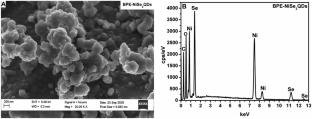Electrochemical Detection of Nevirapine Using Banana Peel Extract Functionalised Nickel Selenide Quantum Dots
Abstract
Nickel selenide quantum dots (NiSe2QDs) were synthesised using the aqueous colloidal method with banana peel extract (BPE) utilised as a capping agent. A gold electrode modified with the BPE-capped NiSe2QDs was used for the determination of nevirapine. Characterisation of the BPE-NiSe2QDs was conducted using high-resolution scanning electron microscopy (HRSEM), high-resolution transmission microscopy (HRTEM) and small-angle X-ray scattering (SAXS) which all revealed the spherical morphology of the QDs and their small sizes (˂ 10 nm). Optical properties of the BPE-NiSe2QDs studied by ultraviolet–visible spectroscopy (UV–Vis) revealed an absorbance band at 329 nm corresponding to an energy bandgap value of 2.99 eV. The electrochemical experiments were performed using differential pulse voltammetry. The Au/BPE-NiSe2QDs/Nafion-based electrochemical sensor showed a distinctive anodic response towards nevirapine at 0.76 V. The results obtained showed that the oxidation peak current increased linearly as the nevirapine concentrations increased in the range 0–1.21 pM (0–0.322 ng/L) with a low limit of detection (LOD) of 0.024 pM (0.0064 ng/L) and sensitivity of 5.52 µA/pM. These exceptional properties are comparable to or even better than already reported sensors for complex matrices. The electrochemical sensor demonstrated high repeatability and stability. The proposed sensor was successfully used for nevirapine detection in spiked wastewater samples with satisfactory results.


 求助内容:
求助内容: 应助结果提醒方式:
应助结果提醒方式:


